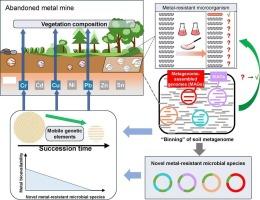金属矿山新型耐金属微生物的识别及其潜在耐药机制
IF 5
2区 农林科学
Q1 SOIL SCIENCE
引用次数: 0
摘要
耐金属微生物是修复金属污染环境的重要资源,但常用的方法只能获得有限的耐药菌株和阐明耐药机制。在本研究中,我们采用宏基因组测序和组装方法,在自然恢复的金属矿山废弃地中鉴定潜在的金属抗性微生物,并探讨其作用机制。结果表明,特定的金属,包括铜(Cu),铅(Pb)和铬(Cr),影响群落组成;特定的微生物可以影响环境中的金属。总体而言,通过分组和组装获得了51个新的金属抗性宏基因组组装基因组(MAGs),其中16个对Cr、Pb和Cu具有有效抗性。16个关键MAGs分属Acidobacteriota、desulfobactero_b和Proteobacteria 3个门和9个属,其中大部分为未知种。这些mag具有多种与转移和运输有关的功能,有助于降低金属的生物利用度。由于16个关键mag包含23个可移动遗传元件,在初始污染环境中,整合酶、1和转运酶基因丰度较高,表明抗性基因水平转移活跃。这些结果报道了具有抗性基因的菌株的新分类群及其金属抗性机制,为后续的功能验证和应用提供了必要的前提。本文章由计算机程序翻译,如有差异,请以英文原文为准。

Recognition of novel metal-resistant microbes and their potential resistance mechanisms in metal mines
Metal-resistant microorganisms are important resources for the remediation of metal-polluted environments, but common methods support only limited acquisition of resistant strains and elucidation of resistance mechanisms. In this study, we used metagenomic binning and assembly to identify potential metal-resistant microorganisms and explore the active mechanisms in a naturally restored metal mine wasteland. The results demonstrated that particular metals, including copper (Cu), lead (Pb) and chromium (Cr), impacted community composition; specific microorganisms can influence metals in the environment. Overall, 51 novel metal-resistant metagenome-assembled genomes (MAGs) were obtained through binning and assembly, 16 of which were effectively resistant to Cr, Pb and Cu. Sixteen key MAGs belonged to three phyla, namely Acidobacteriota, Desulfobacterota_B and Proteobacteria, and nine genera, with the majority representing unidentified species. These MAGs have diverse functions related to transfer and transportation, contributing to reducing metal bioavailability. As the 16 key MAGs included 23 mobile genetic elements, active horizontal resistance gene transfer was demonstrated by the high abundances of integrase, ist and transportase genes in the initial polluted environment. These results report novel taxa of a strain with resistance genes and its metal resistance mechanism, providing the necessary premise for subsequent functional verification and application.
求助全文
通过发布文献求助,成功后即可免费获取论文全文。
去求助
来源期刊

Applied Soil Ecology
农林科学-土壤科学
CiteScore
9.70
自引率
4.20%
发文量
363
审稿时长
5.3 months
期刊介绍:
Applied Soil Ecology addresses the role of soil organisms and their interactions in relation to: sustainability and productivity, nutrient cycling and other soil processes, the maintenance of soil functions, the impact of human activities on soil ecosystems and bio(techno)logical control of soil-inhabiting pests, diseases and weeds.
 求助内容:
求助内容: 应助结果提醒方式:
应助结果提醒方式:


